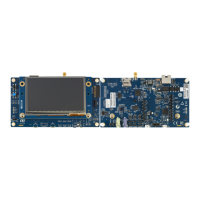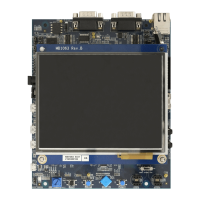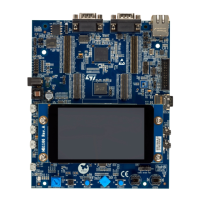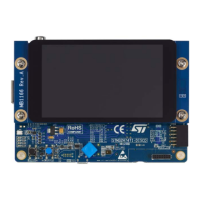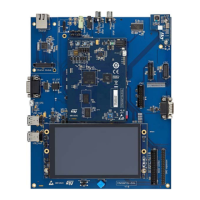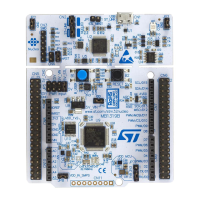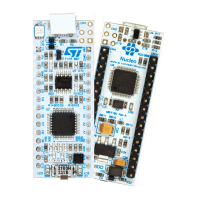Hardware modifications are listed in Table 46 below:
Table 46. Configuration for SRAM A0-A5, A10-11 addresses, and command
Pin name Signal name Setting
SRAM
(1)
PF0
FMC_A0 R339 ON
OCSPI2_IO0 R98
OFF
(2)
PF1
FMC_A1 R335 ON
OCSPI2_IO1 R89
OFF
(2)
PF2
FMC_A2 R331 ON
OCSPI2_IO2 R82
OFF
(2)
PF3
FMC_A3 R74 ON
OCSPI2_IO3 R75
OFF
(2)
PG0
FMC_A10 R73 ON
OCSPI2_IO4 R76
OFF
(2)
PG1
FMC_A11 R333 ON
OCSPI2_IO5 R77
OFF
(2)
PF4
FMC_A4 R66 ON
OCSPI2_CLK R319
OFF
(2)
PF5
FMC_A5 R65 ON
OCSPI2_NCLK R318
OFF
(2)
PG10
FMC_NE3
(3)
R280 / JP2 ON / [1-2]
SDIO2_D1 R280 / JP2
OFF
(2)
/ OFF
OCSPI2_IO6 R115
OFF
(2)
DCMI_D2
(3)
R118
OFF
(2)
1. The default setting is in bold.
2. Remove to avoid stub if necessary.
3. PG10 signal is supplied by VDDMMC. Make sure to supply 3.3 V on VDDMMC (Refer to Section 6.3.5 )
Note: If using SD card 1 (Default configuration), use FMC_NE3 = PG10, then SD card 2 cannot be used). If using SD
card 2, use FMC_NE3 = PC8 by fitting JP12 [2-3], then SD card 1 cannot be used.
8.1.4 Limitations and hardware configuration for SRAM A19 (Just for the test)
Limitations with primary functions: Wi‑Fi
®
SPI.
Limitations with secondary functions: SAI1 and TRACE cannot be used.
UM2662
SRAM
UM2662 - Rev 1
page 51/95
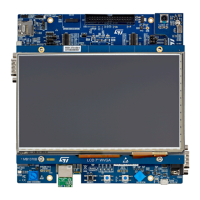
